Snow adventures
This year’s snowfall is welcome for many reasons, not the least of which is the chance to ski, snowshoe, or snowmobile.
DNR lands offers popular winter trails at Ahtanum Meadows, Whites Ridge, Lower Red Saddle, Lily Lake, Rattlesnake, and 29 Pines. One of DNR's most popular winter recreation areas is our 50-mile Mount Tahoma cross-country ski and showshoe trail system, which includes 20 miles of groomed trail. The trails access three backcountry ski huts, managed by the Mount Tahoma Trails Assocation. To park at this sno-park, you'll need an all-season Sno-Park Permit; OR a one-day Sno-Park Permit AND either a one-day Discover Pass or an annual Discover Pass.
Use our below graphic for tips to help you enjoy your favorite winter adventure on DNR-managed lands while preserving both Washington’s landscapes and yourself. Click the image to enalarge.
One important winter tip is to plan in advance for seasonal recreation closures. Closures serve to protect wildlife and/or preserve roads and trails for summertime fun.

Tahoma State Forest. Photo/ Jason Goldstein, DNR.
Don't let your day out get cut short. Bookmark our state trust lands and natural areas pages so a fun day in the snow doesn’t get cut off early by seasonal closures. From these two pages you can quickly get to detailed information for all our recreation sites, including seasonal closures. Or, contact your region’s DNR office for closure information.
Northwest Region (Bellingham, Everett, Sedro Woolley) 360-856-3500
South Puget Sound Region (Olympia, Enumclaw, Seattle) 360-825-1631
Olympic Region (Olympic Peninsula, Forks, Ocean Shores) 360-374-2800
Pacific Cascade Region (Long Beach, Vancouver, Castle Rock) 360-577-2025
Southeast Region (Ellensburg, North Bend, Yakima) 509-925-8510
Northeast Region (Okanogan, Colville, Methow) 509-684-7474
South Puget Sound Region (Olympia, Enumclaw, Seattle) 360-825-1631
Olympic Region (Olympic Peninsula, Forks, Ocean Shores) 360-374-2800
Pacific Cascade Region (Long Beach, Vancouver, Castle Rock) 360-577-2025
Southeast Region (Ellensburg, North Bend, Yakima) 509-925-8510
Northeast Region (Okanogan, Colville, Methow) 509-684-7474
DNR sustainably manages 3 million acres of state trust lands to earn revenue for trust beneficiaries, providing money for schools, hospitals, emergency services, and lots of other services Washingtonians need. These lands also provide opportunities for wildlife and access to winter (and summer) outdoor adventures.


